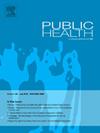通过妇女虐待筛查工具对妇女实施亲密伴侣暴力:covid -19之前和之后的演变
IF 3.2
3区 医学
Q1 PUBLIC, ENVIRONMENTAL & OCCUPATIONAL HEALTH
引用次数: 0
摘要
目的基于公共卫生监测系统中妇女虐待筛查工具(WAST)简表,分析2019冠状病毒病(covid -19)发生前后,女性遭受亲密伴侣暴力(IPV)的时间趋势。研究designCross-sectional。方法资料来源为马德里社区非传染性疾病风险因素监测系统(18-64岁)。WAST的简短形式包括两个问题。当女性报告说她在夫妻关系中经历了一些/很多的紧张关系,并且在解决争吵方面遇到了一些/很大的困难时,就会考虑WAST阳性评分(WAST+)。WAST+被认为是IPV的代理。获得了2019冠状病毒病(2018年、2019年)之前年份、大流行年份(2020年、2021年、2022年)以及之后年份(2023年)的患病率。此外,我们还分析了一些健康指标,包括抑郁症(根据PHQ-8问卷)、自我感知健康和酒精和烟草使用。以95%置信区间(95% CI)计算患病率,并根据研究年份和社会经济变量进行粗校正,使用泊松回归模型估计患病率(aPR)。结果在4791名受访女性中,WAST+的患病率为13.5% (95% CI: 12.5-14.5),年范围为10.7% (95% CI: 8.7-13.0)至16.7% (95% CI: 14.2-19.4)。在covid -19之前和之后的时期之间没有发现差异。ast +与抑郁(aPR: 2.54; 95% CI: 2.16-2.98)、自我感觉健康状况差或非常差(aPR: 1.94; 95% CI: 1.39-2.71)、高危饮酒(aPR: 1.54; 95% CI: 1.10-2.17)和吸烟(aPR: 1.44; 95% CI: 1.23-1.68)相关。结论新冠肺炎前后IPV均未发生变化。在以人口为基础的公共卫生监测调查中,WAST阳性评分与健康状况不佳指标之间的关联加强了它对监测IPV的有用性。本文章由计算机程序翻译,如有差异,请以英文原文为准。
Intimate partner violence against women through the Woman Abuse Screening Tool (WAST): pre- and post-COVID-19 evolution
Objectives
To analyse the temporal trend of the intimate partner violence (IPV) against women, based on the Woman Abuse Screening Tool (WAST) short form within the public health surveillance system, in the pre-and post-COVID-19 periods.
Study design
Cross-sectional.
Methods
The source of information was the Non-communicable Disease Risk-Factor Surveillance System (18–64 years) of the community of Madrid. The WAST short form includes two questions. WAST positive scoring (WAST+) was considered when woman reported that she had experienced some/a lot of tension in the couple's relationships and some/great difficulty in working out arguments. WAST+ was considered a proxy for IPV. Prevalence rates were obtained for years prior to the COVID-19 (2018, 2019), pandemic years (2020, 2021, 2022), and beyond (2023). Also, we analysed some health indicators included depression (according PHQ-8 questionnaire), self-perceived health, and alcohol and tobacco use with WAST+. Prevalence rates were calculated with 95 % confidence intervals (95 % CI) and crude and adjusted for year of study and socioeconomic variables prevalence ratios (aPR) were estimated using Poisson regression models.
Results
Among 4791 women surveyed, the prevalence of WAST+ was 13.5 % (95 % CI: 12.5–14.5), with an annual range from 10.7 % (95 % CI: 8.7–13.0) to 16.7 % (95 % CI: 14.2–19.4). No differences were found between the pre- and post-COVID-19 periods. WAST+ was associated with depression (aPR: 2.54; 95 % CI: 2.16–2.98), self-perceived health as bad or very bad (aPR: 1.94; 95 % CI: 1.39–2.71), high-risk alcohol consumption (aPR: 1.54; 95 % CI: 1.10–2.17) and tobacco consumption (aPR: 1.44; 95 % CI: 1.23–1.68).
Conclusions
No changes in IPV were identified in the pre- and post-COVID-19 periods. The association of a positive WAST score with indicators of poor health reinforces its usefulness for monitoring IPV in population-based public health surveillance surveys.
求助全文
通过发布文献求助,成功后即可免费获取论文全文。
去求助
来源期刊

Public Health
医学-公共卫生、环境卫生与职业卫生
CiteScore
7.60
自引率
0.00%
发文量
280
审稿时长
37 days
期刊介绍:
Public Health is an international, multidisciplinary peer-reviewed journal. It publishes original papers, reviews and short reports on all aspects of the science, philosophy, and practice of public health.
 求助内容:
求助内容: 应助结果提醒方式:
应助结果提醒方式:


